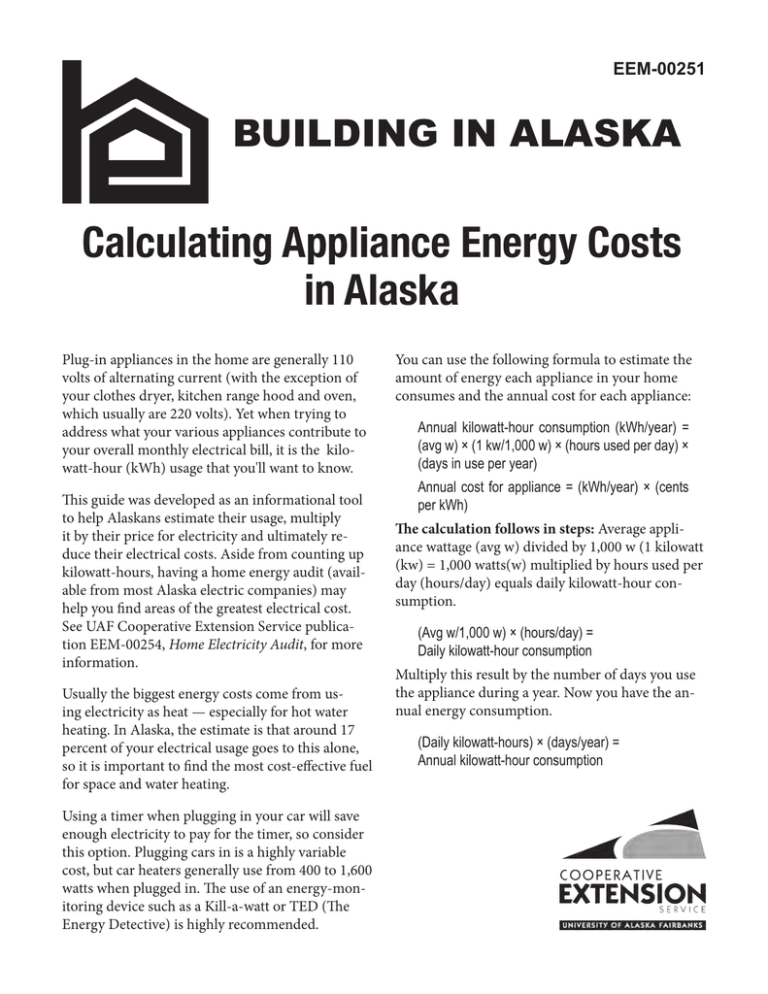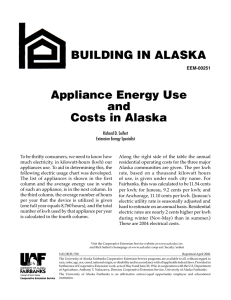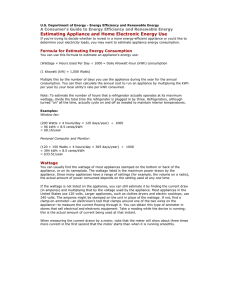Calculating Appliance Energy Costs in Alaska
advertisement

EEM-00251 BUILDING IN ALASKA Calculating Appliance Energy Costs in Alaska Plug-in appliances in the home are generally 110 volts of alternating current (with the exception of your clothes dryer, kitchen range hood and oven, which usually are 220 volts). Yet when trying to address what your various appliances contribute to your overall monthly electrical bill, it is the kilowatt-hour (kWh) usage that you'll want to know. This guide was developed as an informational tool to help Alaskans estimate their usage, multiply it by their price for electricity and ultimately reduce their electrical costs. Aside from counting up kilowatt-hours, having a home energy audit (available from most Alaska electric companies) may help you find areas of the greatest electrical cost. See UAF Cooperative Extension Service publication EEM-00254, Home Electricity Audit, for more information. Usually the biggest energy costs come from using electricity as heat — especially for hot water heating. In Alaska, the estimate is that around 17 percent of your electrical usage goes to this alone, so it is important to find the most cost-effective fuel for space and water heating. Using a timer when plugging in your car will save enough electricity to pay for the timer, so consider this option. Plugging cars in is a highly variable cost, but car heaters generally use from 400 to 1,600 watts when plugged in. The use of an energy-monitoring device such as a Kill-a-watt or TED (The Energy Detective) is highly recommended. You can use the following formula to estimate the amount of energy each appliance in your home consumes and the annual cost for each appliance: Annual kilowatt-hour consumption (kWh/year) = (avg w) × (1 kw/1,000 w) × (hours used per day) × (days in use per year) Annual cost for appliance = (kWh/year) × (cents per kWh) The calculation follows in steps: Average appliance wattage (avg w) divided by 1,000 w (1 kilowatt (kw) = 1,000 watts(w) multiplied by hours used per day (hours/day) equals daily kilowatt-hour consumption. (Avg w/1,000 w) × (hours/day) = Daily kilowatt-hour consumption Multiply this result by the number of days you use the appliance during a year. Now you have the annual energy consumption. (Daily kilowatt-hours) × (days/year) = Annual kilowatt-hour consumption To arrive at the annual cost for each appliance, multiply the annual kilowatt-hour consumption by your local utility's kilowatt-hour rate. (kWh/year) × (kilowatt-hour rate) = Annual cost for appliance A sample calculation using a 60-watt incandescent light bulb: 60 watts (avg w) divided by 1,000 equals .06 kw. Multiply this by 24 hours per day and 365 days per year, which equals 525 kWh (annual kWh consumption). If you live in Fairbanks, multiply by $.23 per kWh (Fairbanks kilowatt-hour rate), which comes to about $120 per year. You can usually find the wattage of most appliances stamped on the bottom or the back of the appliance or on its “nameplate.” The wattage listed is the maximum power drawn by the appliance. Since many appliances have a range of settings, the actual amount of power consumed depends on the setting used. Finally, remember that many appliances continue to draw power even when switched off. These “phantom loads” occur in most appliances that use electricity, such as VCRs, TVs, computers and kitchen appliances. Most phantom loads will increase the appliance’s energy consumption by a few watts. www.uaf.edu/ces or 1-877-520-5211 Art Nash, Extension Energy Specialist Published by the University of Alaska Fairbanks Cooperative Extension Service in cooperation with the United States Department of Agriculture. The University of Alaska Fairbanks is an affirmative action/equal opportunity employer and educational institution. ©2016 University of Alaska Fairbanks. 5-83/RDS/4-16 Revised April 2016








